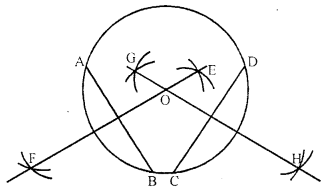ML Aggarwal Class 6 Solutions for ICSE Maths Chapter 13 Practical Geometry Ex 13.2
Question 1.
Draw a line segment \(\overline{\mathrm{PQ}}\) =5.6 cm. Draw a perpendicular to it from a point A outside \(\overline{\mathrm{PQ}}\) by using ruler and compass.
Solution:
Given: A-Line segment PQ = 5.6 cm and a point A outside the line.
Required: To draw a 1 ar to PQ from point A.
Steps of construction :
(i) With A as centre and any suitable radius,
drawn an arc to cut the line PQ at points C and D.
(ii) With C and D as centres, drawn two arcs of equal radius \(\left(>\frac{1}{2} \mathrm{CD}\right)\)
cutting each other at B on the other side of PQ.
(iii) Join A and B to meet the line PQ at N,
then AN is the required perpendicular from the point A to the line PQ.
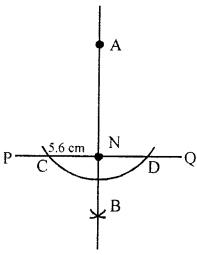
Question 2.
Draw a line segment \(\overline{\mathrm{AB}}\) = 6.2 cm. Draw a perpendicular to it at a point M on \(\overline{\mathrm{AB}}\) by using ruler and compass.
Solution:
Given: A line AB = 6.2 cm and a point P on it.
Required: To draw an ⊥ arc to AB at point P.
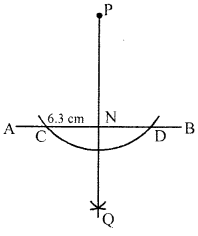
Step of Construction :
(i) With P as centre and any suitable radius,
draw an arc to cut the line AB at points C and D.
(ii) With C and D as centres,
draw two arcs of equal radius \(\left(>\frac{1}{2} \mathrm{CD}\right)\) cutting each other at Q.
(iii) Join P and Q.
then QP is the required perpendicular to the line AB at the point P.
Question 3.
Draw a line l and take a point P on it. Through P, draw a line segment \(\overline{\mathrm{PQ}}\) perpendicular to l. Now draw a perpendicular to \(\overline{\mathrm{PQ}}\) at Q (use ruler and compass).
Solution:
Steps of construction :
(i) Let AB be the given line segment.
(ii) With A as centre and any suitable radius \(\left(>\frac{1}{2} \mathrm{CD}\right)\)
draw arcs on each side of AB.
(iii) With B as centre and same radius [as in step (i)],
draw arcs on each side of AB to cut the previous arcs at P and Q.
(iv) Draw a line passing through points P and Q,
then the lines \(\overline{\mathrm{PQ}}\) is the required perpendicular bisector of AB and line l.

Question 4.
Draw a line segment \(\overline{\mathrm{AB}}\) of length 6.4 cm and construct its axis of symmetry (use ruler and compass).
Solution:
Steps of construction :
(i) Draw a line segment \(\overline{\mathrm{AB}}\) of length 6.4 cm.
(ii) With A as centre, using a compass, draw a circle.
The radius of this circle should be more than half of the length of AB.
(iii) With the same radius and with B as centre,
draw another circle using a compass.
Let it cut the previous circle at C and D.
(iv) Join \(\overline{\mathrm{CD}}\). Then, \(\overline{\mathrm{CD}}\) is the axis of symmetry of \(\overline{\mathrm{AB}}\).

Question 5.
Draw the perpendicular bisector of \(\overline{\mathrm{XY}}\) whose length is 8.3 cm.
(i) Take any point P on the bisector drawn. Examine whether PX = PY.
(ii) If M is the mid-point of \(\overline{\mathrm{XY}}\), what can you say about the lengths MX and MY?
Solution:
Steps of construction :
(i) Draw a line segment \(\overline{\mathrm{XY}}\) of length 8.3 cm.
(ii) With X as centre, using compass, draw a circle.
The radius of this circle should be more than half of the length of \(\overline{\mathrm{XY}}\).
(iii) With the same radius and with Y as centre,
draw another circle using a compass.
Let it cut the previous circle at A and B.
(iv) Join AB.
Then, \(\overline{\mathrm{AB}}\) is the perpendicular bisector of the line segment \(\overline{\mathrm{XY}}\).

(a) On examination, we find the PX = PY.
(b) We can say that the length of MX is Equal to the length of MY.
Question 6.
Draw a line segment of length 8.8 cm. Using ruler and compass, divide it into four equal parts. Verify by actual measurement.
Solution:
Steps of construction :
(i) Draw a line segment \(\overline{\mathrm{AB}}\) of length 8.8 cm.
(ii) With A as centre, using compass,
draw two arcs on either side of AB.
The radius of this arc should be more than half of the length of \(\overline{\mathrm{AB}}\).
(iii) With the same radius and with B as ctntre,
draw another arc using compass.
Let it cut the previous arc at C and D.
(iv) Join \(\overline{\mathrm{CD}}\).
It cuts \(\overline{\mathrm{AB}}\) at E.
Then \(\overline{\mathrm{CD}}\) is the perpendicular bisector of the line segment \(\overline{\mathrm{AB}}\).
(v) With A as centre, using compass, draw a circle.
The radius of this circle stould be more than half of the length of Ac.
(vi) With the same radius and with E as ceitre,
draw another circle using compass.
Let it cut the previous circle at F ana G.
(vii) Join \(\overline{\mathrm{FG}}\) . It cuts \(\overline{\mathrm{AE}}\) at H.
Then \(\overline{\mathrm{FG}}\) is the perpendicular bisector of the line segment \(\overline{\mathrm{AE}}\).
(viii) With E as centre, using eompass, draw a circle.
The radius of thii circle slould be more than half of the length of EB.
(ix) With the same radius md with B is centre,
draw another circle using compss.
Let it cut the previous cirde at I and J.
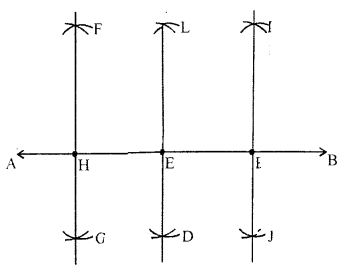
(x) Join \(\overline{\mathrm{IJ}}\) . It cuts \(\overline{\mathrm{EB}}\) at K.
Then \(\overline{\mathrm{IJ}}\) is the perpendicuir bisector of the lhe segment \(\overline{\mathrm{EB}}\).
Now, the points H, E and K divide AB into four equal parts. i. e.,
\(\overline{\mathrm{AH}}\) = \(\overline{\mathrm{HE}}\) = \(\overline{\mathrm{EK}}\) = \(\overline{\mathrm{KB}}\)
By measurement,
\(\overline{\mathrm{AH}}\) = \(\overline{\mathrm{HE}}\) = \(\overline{\mathrm{EK}}\) = \(\overline{\mathrm{KB}}\) = 2.2 cm
Question 7.
With \(\overline{\mathrm{PQ}}\) of length 5.6 cm as diameter, draw a circle.
Solution:
Steps of construction :
(i) Draw a line segment \(\overline{\mathrm{PQ}}\) of length 5.6 cm.
(ii) With P as centre, using compass, draw a circle.
The radius of this circle should be more than half of the length of \(\overline{\mathrm{PQ}}\).
(iii) With the same radius and with Q as centre,
draw another circle using compass.
Let it cut the previous circle at A and B.
(iv) Join \(\overline{\mathrm{AB}}\). It cuts \(\overline{\mathrm{PQ}}\) at C.
Then AB is the perpendicular bisector of the line segment \(\overline{\mathrm{PQ}}\).
(v) Place the pointer of the compass at C
and open the pencil up to P.
(vi) Turn the compass slowly to draw the circle.
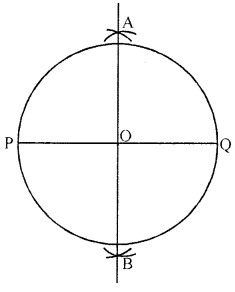
Question 8.
Draw a circle with centre C and radius 4.2 cm. Draw any chord AB. Construct the perpendicular bisector of AB and examine if it passes through C.
Solution:
Steps of construction :
(i) Draw a point with a sharp pencil aid mark it as C.
(ii) Open the compass for the required radius of 4.2 cm,
by putting the pointer on 0 and opening the pencil up to 4.2 cm.
(iii) Place the pointer of the compass at C.
(iv) Turn the compass slowly to draw the circle.
(v) Draw any chord \(\overline{\mathrm{AB}}\) of this circle.
(vi) With A as centre, using compass, draw a circle.
The radius of this circle should be more than half of the length of \(\overline{\mathrm{AB}}\).
(vii) With the same radius and with B as centre,
draw another circle using compass.
Let it cut the previous circle at D and E.
(viii) Join \(\overline{\mathrm{DE}}\).
Then \(\overline{\mathrm{DE}}\) is the perpendicular bisector of the line segment \(\overline{\mathrm{AB}}\).
On examination, we find that it passes through C.
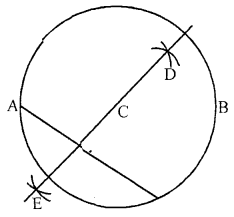
Question 9.
Draw a circle of radius 3.5 cm. Draw any two of its (non-parallel) chords. Construct the perpendicular bisectors of these chords. Where do they meet?
Solution:
Steps of construction :
(i) Draw a point with a sharp pencil and mark it as O.
(ii) Open the compasses for the required radius 3.5 cm,
by putting the pointer on 0 and opening the pencil upto 3.5 cm.
(iii) Place the pointer of the compass at O.
(iv) Turn the compass slowly to draw the circle.
(v) Draw any two chords \(\overline{\mathrm{AB}}\)B and \(\overline{\mathrm{CD}}\) of this circle.
(vi) With A as centre, using compass, draw two arcs on either side of AB.
The radius of this arc should be more than half of the length of \(\overline{\mathrm{AB}}\).
(vii) With the same radius and with B as centre,
draw another two arcs using compass.
Let it cut the previous circle at E and F.
(viii) Join \(\overline{\mathrm{EF}}\).
Then \(\overline{\mathrm{EF}}\) is the perpendicular bisector of the chord \(\overline{\mathrm{AB}}\).
(ix) With C as centre, using compass,
draw two arcs on either side of CD.
The radius of this arc should be more than half of the length of \(\overline{\mathrm{CD}}\).
(x) With the same radius and with D as centre,
draw another two arcs using a compass.
Let it cut the previous circle at G and H.
(xi) Join \(\overline{\mathrm{GH}}\).
Then \(\overline{\mathrm{GH}}\) is the perpendicular bisector of the chord \(\overline{\mathrm{CD}}\).
We find that perpendicular bisectots \(\overline{\mathrm{EF}}\) and \(\overline{\mathrm{GH}}\) meet at O,
the centre of the circle.
